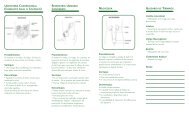Continent Diversion - United Ostomy Associations of America
Continent Diversion - United Ostomy Associations of America
Continent Diversion - United Ostomy Associations of America
You also want an ePaper? Increase the reach of your titles
YUMPU automatically turns print PDFs into web optimized ePapers that Google loves.
continued from page 10<br />
due to inadequate length <strong>of</strong> the<br />
small intestine. In these unusual<br />
situations, a continent ileostomy<br />
can be immediately created so the<br />
patient does not have to undergo<br />
a subsequent operation or have an<br />
unexpected permanent ileostomy.<br />
Those with other medical<br />
conditions that make anesthesia<br />
and surgery excessively risky or<br />
have known small bowel Crohn’s<br />
disease are not considered viable<br />
candidates.<br />
After Surgery<br />
Immediately post-operatively, it<br />
is common to experience urgency,<br />
frequency and slight bowel<br />
incontinence. Once the pouch has<br />
healed and had a chance to enlarge,<br />
approximately three to eight bowel<br />
movements a day can be expected.<br />
The average is four to six times a<br />
day. There are very few dietary or<br />
activity restrictions.<br />
Pros and Cons<br />
The main advantage <strong>of</strong> an<br />
ileoanal pouch is the ability to<br />
evacuate stool in the usual fashion<br />
through the anus. There is no need<br />
for supplies or catheters.<br />
Some patients experience “butt<br />
burn” after surgery. This is due to<br />
high stool frequency and slight<br />
incontinence. This subsides after the<br />
initial adjustment period. Like the<br />
continent ileostomy, pouchitis is the<br />
most common complication. Bowel<br />
obstruction, pelvic infection, fi stula<br />
and stenosis are also complications<br />
<strong>of</strong> this surgery.<br />
Complications<br />
1. Pouchitis – urgency, frequency,<br />
painful straining, bleeding and<br />
incontinence. See continent<br />
ileostomy for treatment options.<br />
2. Bowel obstruction – nausea,<br />
vomiting, bloated and unable to<br />
pass stool. Early in recovery, this can<br />
be due to food not chewed properly.<br />
Later, it is caused by adhesions<br />
that kink the small intestines. The<br />
majority <strong>of</strong> obstruction can be<br />
resolved without surgery.<br />
3. Pelvic infection – fever, chills,<br />
lack <strong>of</strong> energy. The cause is a result<br />
<strong>of</strong> a leak where the bowel is newly<br />
connected. This occurs in about 6%<br />
<strong>of</strong> patients and can be treated with<br />
antibiotics or by placing a drain in<br />
the site that is infected.<br />
4. Stenosis – incomplete<br />
emptying <strong>of</strong> the bowel or frequent,<br />
urgent bowel movements. It is<br />
rarely a signifi cant problem and<br />
can resolve by gentle dilation <strong>of</strong><br />
the anastomosis digitally or with<br />
specialized dilators.<br />
Summary<br />
Patient satisfaction and quality<br />
<strong>of</strong> life scores with ileal internal<br />
reservoir surgery have been high. As<br />
the operations continue to evolve,<br />
patients are also having fewer<br />
complications and better function<br />
over the long term. Many <strong>of</strong> the<br />
problems experienced early in the<br />
development <strong>of</strong> these procedures<br />
have been greatly reduced or<br />
eliminated.<br />
Psychosocial adjustment to the<br />
reservoirs depends on many things,<br />
such as whether complications<br />
occur, the ability to resume a<br />
normal lifestyle and the expertise<br />
<strong>of</strong> the health care team in providing<br />
routine care, education and<br />
emotional support in managing any<br />
complications that may develop.<br />
The ability to return to a normal,<br />
healthy life without an external<br />
appliance or without urgency and<br />
rectal bleeding from ulcerative<br />
colitis, can help achieve a sense<br />
<strong>of</strong> emotional well-being. There is<br />
usually a great sense <strong>of</strong> relief after<br />
these procedures and even elation at<br />
having been given a second chance<br />
at life because the patient’s perceived<br />
health has greatly improved.<br />
The need for surgery and the<br />
choice <strong>of</strong> operation are major<br />
decisions. Patients are encouraged<br />
to learn as much as possible about<br />
their disease and the treatment<br />
options.<br />
References and Additional<br />
Reading<br />
1. Gordon, Phillip : Principles<br />
and Practice <strong>of</strong> surgery for the colon,<br />
rectum, and Anus 2nd Edition1999,<br />
pp 860 - 877.<br />
2. Cohen, Jeffery Md Et al,<br />
Disease <strong>of</strong> Colon & Rectum,<br />
Practice Parameters for the Surgical<br />
Treatment <strong>of</strong> Ulcerative Colitis, 48<br />
2005, pp 1997 -2009.<br />
3. Kock, Nils M.D. Intraabdominal<br />
reservoir in Patients with<br />
Permanent Ileostomy Arch Surg<br />
1969;99 pp 223-31.<br />
4. Barnett, WO Current<br />
experiences with the continent<br />
intestinal reservoir. Surg Gynecol<br />
Obstet. 1989; 168 pp 1-5.<br />
5. Fleshner PR, Schoetz DJ.<br />
Surgical management <strong>of</strong> ulcerative<br />
colitis. In Wolff BG, Fleshman JW,<br />
Beck DE, Pemberton JH, Wexner SD<br />
(eds). ASCRS Textbook <strong>of</strong> Colorectal<br />
Surgery. Springer-Verlag, New York.<br />
2007:567-583.<br />
6. Castillo E, Thomassie LM,<br />
Margolin DA, Whitlow CW,<br />
Malcolm J, Beck DE. <strong>Continent</strong><br />
ileostomy: Current Experience. Dis<br />
Colon Rectum 2004;47:629. Dis<br />
Colon Rectum. 2005 ;48 :1263-68.<br />
7. Rolstad, Bonnie Sue RN<br />
BA CWOCN, Ileoanal Reservoir:<br />
Current Management, Distributed<br />
by the Research Foundation <strong>of</strong> the<br />
<strong>America</strong>n Society <strong>of</strong> Colon and<br />
Rectal Surgeons. 2004.<br />
<strong>Continent</strong> <strong>Diversion</strong> New Patient Guide The Phoenix 19








